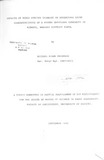| dc.description.abstract | In Kibwezi Dryland Field Station, Makueni district, the
vegetation has changed physiognomically from grassed shrubland
to dense wooded shrubland making the area unsuitable for
cattle grazing. In October 1992 a study was initiated to
document overstorey-understorey relationships following tree
and shrub thinning.
Four treatments of varying tree and shrub density each
replicated four times were randomly imposed in plots measuring
20m by 15m. They consisted of thinning trees and shrubs to the
following canopy covers, 0% (complete clearing), 35.5% (500
shrubs and 167 treesjha), 55.3% (1167 shrubs and 167 treesjha)
and an average of 67.6%- (unthinned treatment with
approximately 1800 shrubs and 400 treesjha).
A clipping method was used to determine the biomass of
herbaceous species while their basal cover and frequency was
obtained by the point frame method. Average biomass production
and basal cover of herbage components (grasses and forbs) for
the study period in relation to woody canopy cover was
analysed using F-test statistic. To quantify these
relationships, simple linear and quadratic regression analyses
were conducted.
XII
Canopy cover reduction had significant effects (P<O.05)
on increases in biomass production and basal cover of grasses,
forbs, and total herbage. There was a strong relationship
between biomass production, basal cover and frequency of
herbaceous species with the over storey canopy cover. The
relationship between woody canopy cover and herbage production
was described by a 2nd degree polynomial equation, i.e.
y-=3493.4-9.806X-O.171X2 (p=O.OOOl, r2=o.946, n=16). The
equation y-=12.07-0.013X-O.0005x2 (p=O.OOOl, r2=o.966, n=16)
described the relationship between woody canopy cover and
basal cover of total herbage. When linear regression equations
were fitted for the two vegetal classes (forbs and grasses) at
varying woody canopy cover, the overall rate of biomass and
basal cover increase for grasses was slightly higher than
forbs. Forbs did better at the lightly thinned treatments.
Competition between woody and herbaceous species both
in the tree and shrub canopy zone and in their root zone
reduced performance of herbaceous spec i.es in the lightly
thinned treatments. A degree of protection from competition
will give herbaceous species advantage over woody species;
this can be achieved through thinning as shown by results of
this study.
It was concluded from the data that in order to
maximize herbage production, tree and shrub density should be
reduced to achieve a canopy cover of not more than 35.5%.
After achieving the desired production potential, a balance
between herbaceous plants and woody species should be
maintained through cattle grazing and fire. | en |

